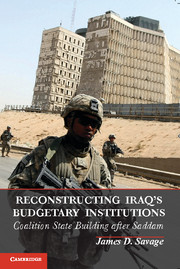Book contents
- Frontmatter
- Dedication
- Contents
- List of Tables
- List of Figures and Illustrations
- Preface
- Abbreviations
- 1 State Building and the Reconstruction of Iraq’s Budgetary Institutions
- 2 The Evolution of Iraqi Budgetary Institutions from the Ottomans and the British Mandate through Saddam
- 3 Prewar Planning for Iraq’s Economic and Budgetary Reconstruction
- 4 Boots on the Ground
- 5 Building Iraqi Ministerial Capacity
- 6 The 17th Benchmark and the Challenge of Iraqi Budget Execution
- 7 Building Iraqi Budgetary Capacity
- 8 Iraqi Budgeting
- 9 Successful State Building in Iraq?
- Bibliography
- Index
- References
9 - Successful State Building in Iraq?
Lessons from the Reconstruction of Iraqi Budgeting
Published online by Cambridge University Press: 05 June 2014
- Frontmatter
- Dedication
- Contents
- List of Tables
- List of Figures and Illustrations
- Preface
- Abbreviations
- 1 State Building and the Reconstruction of Iraq’s Budgetary Institutions
- 2 The Evolution of Iraqi Budgetary Institutions from the Ottomans and the British Mandate through Saddam
- 3 Prewar Planning for Iraq’s Economic and Budgetary Reconstruction
- 4 Boots on the Ground
- 5 Building Iraqi Ministerial Capacity
- 6 The 17th Benchmark and the Challenge of Iraqi Budget Execution
- 7 Building Iraqi Budgetary Capacity
- 8 Iraqi Budgeting
- 9 Successful State Building in Iraq?
- Bibliography
- Index
- References
Summary
This book examines the challenge of making of institutional change under highly adverse circumstances, specifically the attempt by the American-led Coalition to change indigenous government institutions following its invasion and subsequent nine-year conflict-ridden occupation of Iraq. This project focuses on one aspect of the Coalition’s state-building and counterinsurgency efforts, the stabilization and reconstruction of the Iraqi government’s vital budgeting system. The importance of budgeting, as various literatures on state building, failed states, and postconflict peacekeeping indicate, is that sustainable, effective, and responsible public budgeting systems contribute to state legitimacy, bureaucratic capacity, transparent and accountable public finance, and the efficient provision of public goods, services, and infrastructure. The analysis provided here indicates that through invasion, occupation, and aid conditionality, the Coalition achieved some success in imposing a new budgetary framework on the government of Iraq. The Iraqis, in turn, became invested in that process, and they continue to employ it to budget their expanding oil revenues. Building sustainable budgetary institutions stands as a highlight of the occupation. Evaluating the condition of Iraq’s budgeting, U.S. Ambassador James Jeffrey remarked after the withdrawal of American troops in 2012, “This is a serious, serious, functioning part of Iraq. Many things about Iraq still don’t function, but the budgeting process, the pledge to the IMF, the budget discipline on the ministries. . . . It’s a miracle. It’s something we had a great deal to do with earlier; we have only a limited amount to do with it now, because it’s sort of on autopilot. . . . This is one of the first things they [the Iraqis] got right, with a lot of help from us. So it’s a success story.”
- Type
- Chapter
- Information
- Reconstructing Iraq's Budgetary InstitutionsCoalition State Building after Saddam, pp. 247 - 262Publisher: Cambridge University PressPrint publication year: 2013



